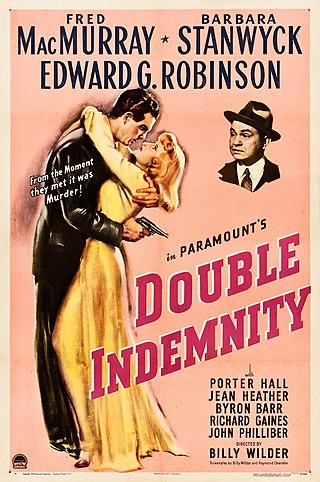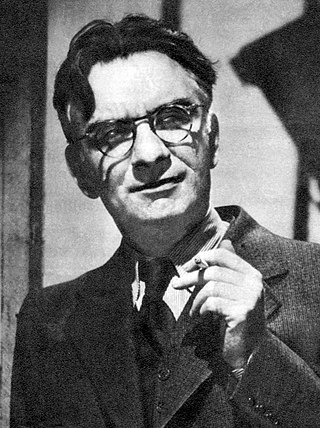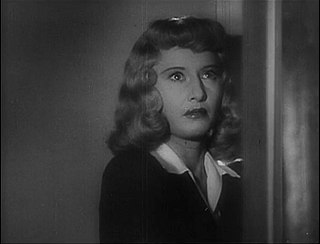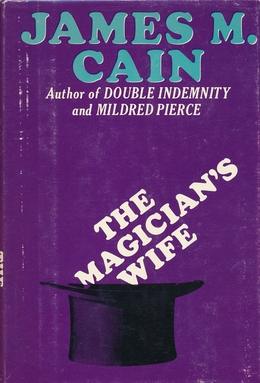
Double Indemnity is a 1944 American crime film noir directed by Billy Wilder, co-written by Wilder and Raymond Chandler, and produced by Buddy DeSylva and Joseph Sistrom. The screenplay was based on James M. Cain's 1943 novel of the same title, which appeared as an eight-part serial for Liberty magazine in February 1936.

Mildred Pierce is a psychological drama by James M. Cain published by Alfred A. Knopf in 1941.

James Mallahan Cain was an American novelist, journalist and screenwriter. He is widely regarded as a progenitor of the hardboiled school of American crime fiction.

The Postman Always Rings Twice is a 1934 crime novel by American writer James M. Cain. The novel was successful and notorious upon publication. It is considered one of the most outstanding crime novels of the 20th century. The novel's mix of sexuality and violence was startling in its time and caused it to be banned in Boston.

Phyllis Dietrichson is a fictional character in the book and two film adaptations of James M. Cain's novella Double Indemnity. For the 1944 film of the same name, Barbara Stanwyck was nominated for the Academy Award for Best Actress. The character is considered one of the best femme fatale roles in film noir history. The character was ranked as the #8 film villain of the first 100 years of American cinema by the American Film Institute in the AFI's 100 Years... 100 Heroes and Villains.
Double Indemnity is a 1973 American made-for-television crime film directed by Jack Smight and starring Richard Crenna, Lee J. Cobb, Robert Webber and Samantha Eggar. It was a remake of Double Indemnity (1944) based on the film rather than the original novel.
Career in C Major is an opera-themed novella by American writer James M. Cain, first published in 1938. First appearing as a serial in The American Magazine entitled "Two Can Sing", this comic romance is a departure from Cain's first novels, Postman Always Rings Twice (1934) and Double Indemnity (1936), both hardboiled crime stories that included premeditated murder. Redbook magazine, disappointed that Cain had exchanged his hard-boiled themes involving sex and murder for a "comedic adventure", declined to purchase the novella but Liberty obtained the piece and carried it as a serial in 1935.

Three of a Kind is a collection of three novellas by James M. Cain, published by Alfred A. Knopf in 1943. Each originally appeared as serials in magazines during the 1930s. The collection includes Double Indemnity, first published in 1935 as a serial for Liberty magazine; Career in C Major, originally entitled "Two Can Sing" when it appeared in The American Magazine in 1938; and The Embezzler, appearing in Liberty as "Money and the Woman", also in 1938.

Serenade is a novel by James M. Cain published in 1938 by Alfred A. Knopf. and one of four Cain novels to feature opera as a plot device. Loosely based on Bizet's Carmen, the story explores the sources of artistic development, in particular the role played by sexual orientation in the development of artistic talent.
The Embezzler is a 1938 short novel by James M. Cain. The work first appeared as a serial in Liberty magazine in 1940 under the title Money and the Woman. In 1943, Alfred A. Knopf published the work as The Embezzler in a collection of novellas by Cain entitled Three of a Kind.

Love's Lovely Counterfeit is a hard-boiled short novel by James M. Cain published by Alfred A. Knopf in 1942. The story is set in a Midwestern town where rival gangsters struggle to maintain control of their criminal enterprises. The work is one of only three of Cain's novels told from the third-person point-of-view.

Past All Dishonor is a historical novel by James M. Cain published by Alfred A. Knopf in 1946. The story is set during the American Civil War concerning a tragic love affair between a Confederate spy and a mining-camp prostitute in California and Nevada. The novel, praised by many critics, was one of Cain's most profitable literary successes.

The Butterfly is a hard-boiled novel by author James M. Cain published by Alfred A. Knopf in 1947. The story is set in rural West Virginia in the late 1930s and concerns a mystery surrounding an apparent case of father and daughter incest.

Sinful Woman is a detective novel by James M. Cain that appeared originally as a paperback in 1947 by Avon publishers. Sinful Woman was the most commercially successful of three paperbacks Cain wrote for Avon in the late 1940s and early 1950s.

Galatea is a romance novel by James M. Cain published by Alfred A. Knopf in 1953. The story alludes to the mythological Galatea in which the sculptor Pygmalion falls in love with the ivory figure of a woman he has crafted. In Cain’s modernized version of the Greek legend, an overweight woman is transfigured through a program of weight reduction into a goddess-like beauty.

The Root of His Evil is a novel by James M. Cain published in paperback by Avon in 1951.

Mignon is a historical novel by James M. Cain published by the Dial Press in 1962. Along with Cain's Past All Dishonor (1946), Mignon is one of his two historical novels set during the American Civil War.

The Magician's Wife is a novel by James M. Cain published in 1965 by Dial Press.

Cain X 3 is a collection of three previously published novels by James M. Cain, reissued in 1969 by Alfred A. Knopf, with an introduction by Tom Wolfe.

Jealous Woman is a mystery novel by James M. Cain published in 1950 by Avon.
















